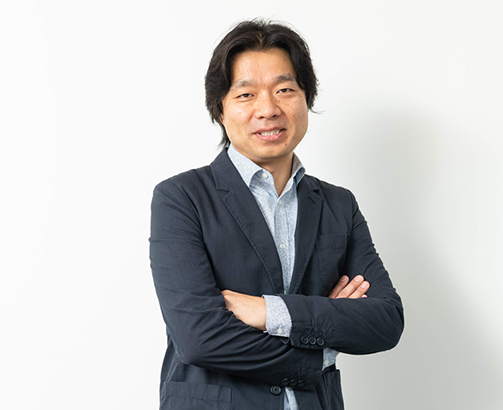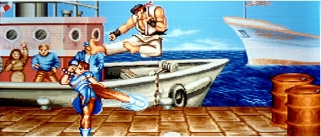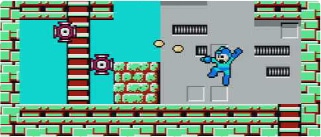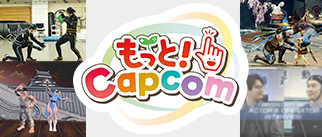
Here Comes a New Challenger:
How Street Fighter is Building an Ecosystem in the Burgeoning Esports Market
There’s a new challenger in the
entertainment market: Esports.
Here’s how Capcom is looking to take it head-on.
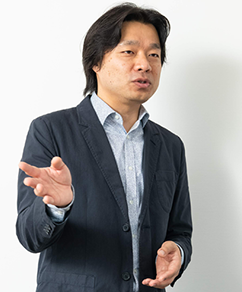
- First, tell us a bit about how you came to Capcom.
- I’d heard from Capcom’s top management that the company was interested in expanding more into esports and felt that with my experience, we’d be a good fit. Our esports division went live in 2018 and I was promoted to its head in April of the following year.
- New beginnings almost always lead to new obstacles, was there a lot of pressure to succeed?
- Starting something new, especially at a company with a long history like Capcom, is always difficult, but with everyone’s help, including buy-in from the CEO and COO, we’ve gotten off to a great start. Sure, there’s pressure at times, but I just focus on pushing through it.
Capcom has been focused on making games fun to watch even before esports became big.
- It sure seems like the esports scene’s been growing and growing!
- Overseas, we saw esports really take off in the last decade, but it didn’t really gain traction here in Japan until about 2016. The Japan esports Union (JeSU), and our own esports division, followed in 2018, which is now seen as the official “start” of the Japan scene—one that is widely expected to grow in the days ahead.
- Why do you think esports took off earlier overseas?
- I think over there, fans are more used to getting together and watching other players compete in events. From there, the whole thing just evolved—whether it’s talking about athletes and their teams, events, or even player leagues and sponsorships—the whole system, market and everything, kind of emerged organically. Plus, PC gaming has always been more popular overseas, so I think it’s just easier for both players and fans to make the transition to competitive, online gaming.
- Well, esports may be more front and center these days, but Capcom’s been holding Street Fighter tournaments for quite some time now, right?
- Back in 1992, before esports was even a word, we had a Street Fighter II tournament at the Ryogoku Kokugikan (known as Ryogoku Sumo Hall). Our CEO (then COO) still has a picture of himself handing out the award. The fact that we were there 28 years ago, working on the foundation of what would later become the esports we know today, just goes to show how well competitive fighting games can thrive as a competitive esport.
- I see. And in what other ways has Capcom been involved with esports since then?
- Street Fighter‘s appeal isn’t just limited to Japan—it’s popular all over the world. Since 2014, our subsidiary Capcom USA has been holding the Capcom Pro Tour, which features the Street Fighter brand and makes stops in several different countries.
- Looks like Japanese companies have recently started to take part in managing their own competitive events as well.
- As are we. Japan may have had a comparatively late start, but we at Capcom are more committed than ever to creating an environment that works for both athletes and potential sponsors.

Capcom is looking to expand the Japanese esports market with 1-on-1 and team-based events.
- Tell us about the current state of domestic esports at Capcom right now.
- It’s been slightly over two years since we started our new esports division, and we’ve been focused on researching what is needed to turn all of this into a sustainable business—things like developing a general framework for how events should be planned and managed. Look at other spectator sports like soccer or baseball: each is comprised of separate—yet individually profitable—ecosystems, like the pro leagues, athletes, their management, businesses, and fans. We want that same, mutually beneficial environment for esports.
- That sounds ambitious. Where do you even begin?
- Building the community. We’ve started by creating an esports club that players can join at one of our amusement facilities. Also, starting from 2018, we at Capcom Japan have held a Capcom Pro Tour Premier tournament event—which had been primarily held outside of Japan—at the Tokyo Game Show.
- You made quite a splash at TGS 2019 as well!
- We were pleased that 2019 was another strong showing. Also at TGS 2019, we took the opportunity to co-host an invitational tournament that brought over players from Asia in an effort to attract global athletes to Japan.
- From which countries did you have athletes come over?
- We invited athletes from many places, including South Korea and Hong Kong. We also had top-ranking players come from Southeast Asian countries like Singapore and Malaysia.
- Any other new endeavors going on?
- We had our first Capcom Street Fighter League tournament start in February 2019. While the Pro Tour consists of 1-on-1 matches between pro athletes, League tournaments are 3-on-3 team battles involving players of all levels. Afterwards, pro players had a chance to reach new heights of success when we introduced team-based Pro Leagues in the US and Japan.
- What led you to start including team battles? Previous events were mostly 1-on-1 events, right?
-
Frankly, we wanted to encourage growth in the Japanese esports community. It’s not enough to simply increase the number of athletes competing in events, you absolutely need more people interested in esports as a whole.
There are plenty of people out there who enjoy playing the game, but have never participated in an esport, or maybe they don’t play at all, but just want to watch as a spectator. It’s our job to give all of these people, and more, the chance to experience, and potentially fall in love with, esports. They may even decide to participate in an event themselves.
We also felt that 3-on-3 matches would offer a bit more depth. In the first Pro League, teams consisted of a pro, a high-level amateur, and a normal player. Now, this gave us the chance to watch team members work and grow together—something not present in your traditional 1-on-1 structure. By designating team spots for amateur and everyday players, we provided an opportunity for them to realize their hidden potentials—hopefully leading to new pro athletes in the process.
- You could watch what was going on in video updates, so I imagine it was easier for more people to follow along.
-
Definitely, it’s an entirely different experience from watching your standard 1-on-1 match. We wanted to make it easier for fans to become invested in these teams over the long term, and putting everything on video gives everyone a chance to see how athletes are working as a team or how the non-pro players are improving.
Then you can go on and show training sessions or other related videos, it all ties together to provide a deeper, more compelling form of entertainment. We’d like to keep building on this model with the end goal being equivalent to what you’d get in any other “real” sport.
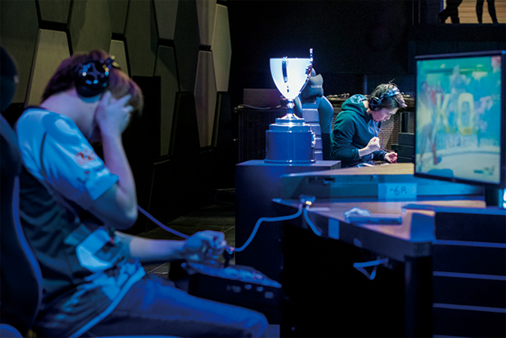
Today’s pro athletes set the stage for a new generation of fighters.
- Requiring both amateurs and beginners to participate must have posed its own set of challenges. I imagine there were those who had no idea what shape that would take.
-
It was something we thought on quite a bit. We ended up creating a series of tournaments that we hoped would help ease players through the transition of going from beginner/amateur to pro. These are some of the tournaments we came up with.
Arcade League Tournaments at arcades across Japan College League Online tournament for university students Rookie’s Caravan Tournaments for beginners at venues such as our Plaza Capcom facilities The Arcade League took place at arcades across Japan, while the College League held online tournaments for university students. Both were team events with 3-on-3 matches. The Rookie’s Caravan held events at six different regions over the course of 2019: Hokkaido, Iwate, Saitama, Hiroshima, Osaka, and Kumamoto.
- If a player won a tournament, what happened next?
-
Players who won at one of these tournaments were allowed to compete in the finals, which we called “Tryout”. (see picture below) Then, pro players serving as team leaders chose which of these players they wanted to draft into their Pro League team. We plan on this being a yearly event.
It all culminated at the Capcom Cup held in Los Angeles at the tail end of 2019. There we had the top two teams from both the US and Japan Pro Leagues square off—the Japanese took home the crown amidst a whole lot of excitement.
- Seems like there’s a lot of new things going on these days!
- The work we did in our first year was a big step in the right direction, and we’re planning on extending those efforts to other countries—not just Japan and the US—in the days ahead. For example, in Asia we can work with local media outlets to provide documentary-like coverage of athletes right up until we send out the invites, kind of a way of showing each team’s path to the top. We already have the Capcom Pro Tour running in Europe, now we just need to apply those same lessons to other areas as well.
- It must help that network connections like 5G get better and better every year. I believe you also held an esports tournament for Capcom employees as a new kind of internal communication tool, right?
- Yeah, this was another first for us. We had our in-house tournament near our Osaka headquarters in front of crowd of about 500 spectators—all employees and their families. It was a great opportunity for all of us, regardless of department or division, to come together, have fun, and share this very direct, hands-on experience of what esports is all about. That we could all enjoy ourselves and get a sense of the potential of esports to appeal to people from all walks of life—it brought home the idea that this is a new business being built by everyone here at Capcom.
- Have any of the development divisions been involved in your work?
- Oh, absolutely. There is no way we could have made it this far without their cooperation. They’ve been instrumental to our efforts, whether it’s their vast experience on how to run a tournament, write beginner-friendly pamphlets or even as on-site cheer guides for our audiences. We maintain tight communications between teams, which fosters a definite feeling that this is a group effort.
- So rather than have clear-cut divisions like, “You make it and we’ll sell it”, it’s more of a team effort…
- Esports as a business is still a new, almost unchartered territory, so there’s a feeling on both sides that we want to do this right and that the details count. There are times when we’ve received some blunt feedback, but I feel like it’s healthy to have that back and forth. Here at Capcom, we all want to make something great and really stick the landing.
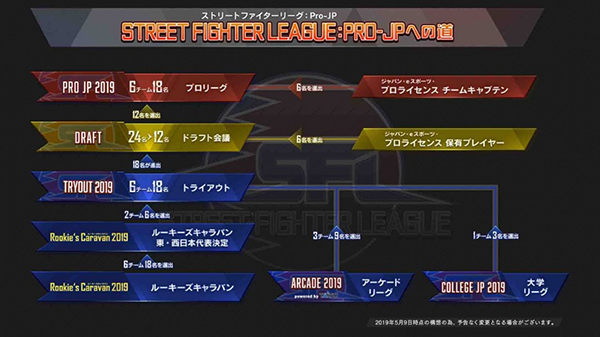
Fun and Profit:
Turning the business of esports today into the entertainment of tomorrow.
- What approach will you use to monetize esports in the days ahead?
- Creating an environment where esports can flourish involves a lot of people: athletes, viewers, game developers, sponsors, event organizers—all are vital to its success. Where organizers might rely on ticket or souvenir sales to generate profits, others might depend on video distribution fees or broadcasting rights for income. Either way, I think it’s of vital importance that we have an ecosystem that provides for everyone, whether it be businesses or spectators.
- How about players at home who don’t participate in tournaments? Do they have a place in this new esports ecosystem?
- I believe so. If we can show them that there’s this whole other layer to the game they’re playing, then I think there’s absolutely a place for them in that ecosystem. You know, it could be watching a major event live, or checking out a video of their favorite player—the more, the merrier!
-
Even more reason to make sure esports is more than just a passing fad.
Last question. Where do you want to go from here? -
This is something that Capcom president Haruhiro Tsujimoto has said as well, but I believe that esports has the potential to be more than a simple fad. First, compared to traditional sports, esports is more egalitarian—everyone, regardless of physical condition or gender, can participate and compete at the highest levels of play. Capcom’s been running Street Fighter tournaments for almost 30 years now, ever since our tournament at the Ryogoku Kokugikan back in 1992. We feel a strong obligation to continue to foster esports as both an economic and cultural commodity.
There’s still so much work to be done, but all of us, top management included, are extremely excited about the days ahead. North America, Europe, Japan, and Asia, we think the potential for esports is there and we’re going to be working hard to bring them to you all.
